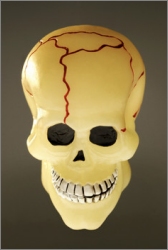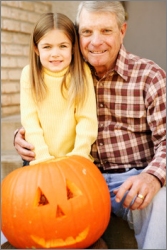A History of Halloween, Witchcraft and
Other Things That Go Bump in the Night
by www.SixWise.com
October has arrived once again, and just like they do every year at this time, people's thoughts turn, just like the colors of the leaves, to Halloween -- and all the fun and spooky things that come with the holiday, such as carnivals, pumpkin-carving, haunted houses and trick-or-treating. But how much do you really know about Halloween, its history, or its various meaning in different cultures?
|

Spooky Halloween decorations and activities can be traumatizing for young children, who don't yet know that the holiday is all in fun.
|
A History of Halloween
Very few people would think to associate Halloween with the Celtic culture of ancient Ireland, but that's exactly where the holiday has its origins. The Celtic celebration of Sanhain (pronounced sow-in) began 2,000 years ago as a way to celebrate the Celtic new year, which was on November 1.
The Celts believed that at the beginning of the new year, the lines between the living and the dead blurred. On October 31, they celebrated Sanhain, which they thought to be the day when the ghosts of the dead returned to earth, causing trouble and damaging crops. They also believed that these spirits made it easier for the Druids, Celtic priests, to see into the future and make predictions.
The Celts celebrated this holiday in a variety of ways, making bonfires in which to burn crops and animal sacrifices, wearing costumes typically made of animal hides and skin, and attempting to tell each others' fortunes. After the festivities came to an end, people re-lit their hearth fires, which they had earlier extinguished previously in the evening, by using the bonfire in the hopes that these sacred flames would protect them during the harsh winter months.
In 43 A.D., the Romans had conquered most of the Celtic lands and with their newfound control combined the Celt's celebration of Sanhain with two of their own. The first of these festivals was Feralia, a day in October on which the Romans commemorated the passing of their dead. The second was a celebration of Pomona, the Roman goddess of fruits and trees. The symbol of Pomona was the apple, and the blending of this tradition with Sanhain has obvious connections to the current tradition of "bobbing" for apples.
By 800, as a more Christian influence spread across the land, Pope Boniface IV designated November 1 All Saint's Day, a time to honor saints and martyrs. The celebration was also referred to as All-hallows or All-hallowmas and the night before it, the night of Sanhain, began to be called All Hallow's Eve, and, eventually, Halloween -- which was celebrated with costumes, parades and big bonfires.
What About Witchcraft?
One of the big traditions associated with Halloween is the practice of witchcraft. Stemming from the Wicca religion, there are many different types of witchcraft that are practiced around the world. Wicca is a religion that celebrates nature and human beings having a peaceful, harmonious relationship with the natural world and seeking the divine in the world around them. With the discovery of cave paintings believed to be around 30,000 years old, it has been suggested that Wicca and the practice of witchcraft is the oldest belief system in the world today.
One form of witchcraft, Alexandrian Witchcraft, is named after its founder, Alexander Sanders, who proclaimed himself the "king of witchcraft." Alexandrian is one of the largest forms of witchcraft to come out of England and places great emphasis on cord and cerebral magic. Alexandrian witchcraft is strongest in Canada and today has no association with its founder.
The most dominant form of witchcraft practiced today is Gardnerian Witchcraft, named after Gerald B Gardner. It focuses on the worship of the Goddess and her consort, the Horned God. Nature and acceptance of all living things is the focus of this practice, as is the belief in reincarnation. Members are initiated into the coven by the High Priestess or Priest and those who enter must do so with "perfect love and perfect trust." The High Priestess is always the head of the coven and rituals are always performed in a magic circle.
Faery Witchcraft is an American tradition founded by Victor Anderson and Gwendolyn Pendderwen. Starting off small and secretive, it has now reached a wide audience. This particular tradition honors nature and worships the deities that personify the forces of nature, life, fertility, death, and rebirth. There's no standard secret book and many practices are kept secret, but most are practiced openly. This tradition provides for the passing of power upon initiation and identifies different forces of energy within the universe. Iron and pearl pentagrams are focuses of key teachings in the faery tradition and are used as meditation tools.
|

Kids of all ages can enjoy the Halloween tradition of carving a jack o' lantern!
|
Seax Witchcraft came about in 1973 and was founded by Raymond Buckland. It is democratic in its leadership and there is no binding or ritual scourging. Covens decide for themselves whether to worship clothed or naked and the tradition is open to anyone. Its rituals are published in The Tree: Complete Book of Saxon Witchcraft.
Keeping it Fun, Not Scary, For Kids
While most adults see Halloween as a time for merriment and indulging in the spooky and mildly scary, if not exposed to the festivities properly many children - especially younger kids - can associate the holiday with death and fear. An adult might have fun shrieking and scaring themselves silly at a haunted house and see no problem with scaring trick-or-treaters of all ages by playing creepy music and appearing at the door wearing a scary mask, but many youngsters will find it frightening or even traumatizing.
According to Cindy Dell Clark, a researcher and professor of human development at Penn State, parents of younger children need to ease them into the holiday. She states that because of the years spent trying to shield children from death and fear, suddenly exposing them to it on Halloween may be overwhelming and scary.
"Halloween is a time when we expose kids to behavior that is not the norm. Children connect the holiday with death," said Clark in Science Daily. "We typically distance ourselves from death and shield children from it, but in this case, young children encounter their fears when they face decorations of skeletons and tombstones."
That said, some of the more appropriate activities for young children include:
-
Pumpkin carving
-
School carnivals
-
Trick-or-treating
-
Halloween parties meant for young kids
-
Hay rides (if you opt for a "haunted" hayride, be sure it is suitable for young children)
Making Sure Your Kids Understand Halloween
As Halloween focuses on death and the occult, parents should be prepared for any questions children may have about death that might crop up this time of year, with all the cardboard tombstones and fake skeletons they come across. It might not be pleasant or comfortable, but properly explaining and answering questions will go a long way toward reassuring your child and easing their fears.
On the other hand, there will be children who are not afraid of Halloween at all. In fact, as it is a holiday where much power is transferred to children -- and asking complete strangers for candy is suddenly acceptable -- many children might see it as a time to push boundaries and try to take advantage.
According to Clark, children tend to see the mock power adults give them on Halloween, with the permission to dress up as grown-ups and access to as much sugar as they can handle, as real power. Therefore, while it is acceptable to indulge your child on Halloween, it is critical for parents to set limits and boundaries for their child's behavior and to communicate them clearly. Letting a child know beforehand that there are behaviors that are unacceptable no matter what time of year it is, and what the consequences off such behaviors are, will help to avoid unpleasant situations once Halloween roles around.
In the end, Halloween is all about having fun and scaring yourself a little. Being prepared and knowing how to handle this out-of-the-ordinary holiday with your children can make the spooks and thrills more fun for you and your family.
Recommended Reading
The 10 Most Haunted Places in America
4 Funny Halloween Photos You've Got to See
Sources
Science Daily September 5, 2005
Paralumun.com Witchcraft
Halloween Origins and Customs